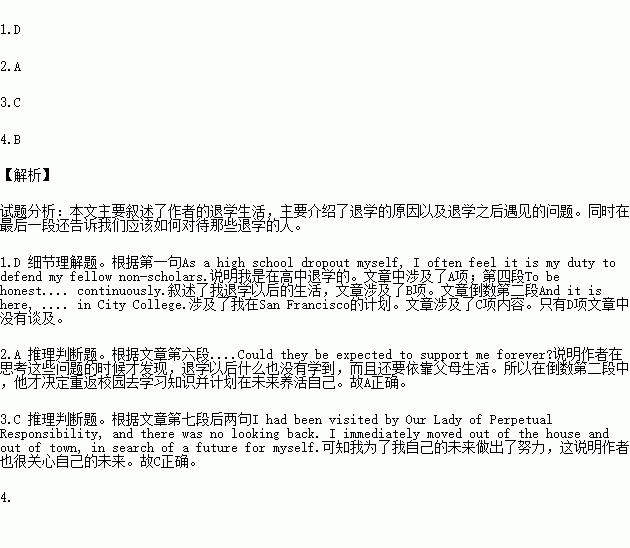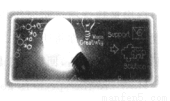题目内容
阅读理解,阅读下面短文,从各题所给的A、B、C、D四个选项中选出最佳选项。
As a high school dropout myself, I often feel it is my duty to defend my fellow non-scholars. Common wisdom would have you believe we are the "bad kids", the future criminals, the worst sort of people. But not all dropouts will deal drugs, shoplift, or even shoot pool all day.
My own favorite hooky hangout was always the public library. My early retirement meant that at last I had the time to read everything I wanted to.
Best of all was the time I finally had to myself. I felt uncontrolled and free. I had been in school nearly my whole life. I wanted to find out for myself who I was, and until I did, everything else felt like a waste of time.
To be honest, though, my daily life as a dropout consisted mostly of long hot baths, afternoon naps, and microwave food. After nearly three years of such self-centered pleasure, a series of strange thoughts began to enter my mind continuously.
Images of myself at the age of 35-still living at home, collecting dust balls on the couch, reading the same book over and over-began to bother me in my sleep. And a voice in my head began asking over and over, "Who is paying the hot water bills? Who buys the microwave pizza?"
The answer, of course, was my poor old parents. Sure, I was having a wonderful time doing plenty of nothing, discovering myself and all, but they were getting a raw deal. What parents long to see their child drop out of school, with no plans for the future? Could they be expected to support me forever?
Certainly not. I had been visited by Our Lady of Perpetual Responsibility, and there was no looking back. I immediately moved out of the house and out of town, in search of a future for myself.
And it is here, in my new home of San Francisco, that I have decided to do what was once unthinkable: go back to school. I plan to take adult education classes and get me GED (General Educational Development), and then enroll in City College.
So next time you see a dropout, that unchangeable anti-student, be understanding. And please don't push him to do something he doesn't want to do. It never works. He'll come around when he's ready.
1.Which question is NOT answered in the article?
A. When did the writer leave school?
B. How was the writer's life as a dropout?
C. What future plans did the writer have in San Francisco?
D. What did the writer's parents say when he dropped out?
2.The writer went back to school because __________.
A. he wanted to learn something and support himself
B. he found the life as a dropout was very unbearable
C. his parents couldn't support him anymore
D. he didn't want to be looked down upon
3.What do we know about the writer from the article?
A. He didn't like studying.
B. He had a busy life as a dropout.
C. He was concerned about his future.
D. He wanted to become a teacher.
4.The writer writes this article mainly to _________.
A. explain why he became a dropout
B. tell people how to treat dropouts
C. prove that not all dropouts are bad
D. show what a dropout's life is really like
任务型阅读
请认真阅读下列短文,并根据所读内容在文章后表格中的空格里填入一个最恰当的单词。
注意:每个空格只填1个单词。请将答案写在答题卡上相应题号的横线上。
Child sponsorship moves beyond the basics
One of the most popular forms of charitable giving in use today is child sponsorship as witnessed by the fact that just one of the leading child sponsorship charities currently has over 1 million individual child sponsors worldwide. Despite this huge level of support, it is not generally understood exactly what child sponsorship actually involves.
Most people tend to assume that one’s chosen charity arranges for sponsors to be matched up with an underprivileged child in one of the poorer underdeveloped countries. The idea is that you essentially take a child under your wing and act almost like a fairy godmother or father until he or she attains adulthood and can stand on his or her own two feet.
To a large extent, this is a pretty accurate impression. New sponsors are matched with individual children and can typically choose which country, which sex and which age group they would prefer. They then exchange photos and letters on a regular basis. This obviously helps the sponsors to see at first-hand how their donations are benefiting the children.
The sponsorship itself costs approximately £15 per month and many donators choose to sponsor more than one child at once. One common wrong impression about these regular donations is that they go direct to the child’s parents or guardian in order to pay for essentials such as food or education. In reality, some of the longest established child sponsorship charities have found that this is largely ineffective and can cause anger among other children in the community who might not be so fortunate.
Instead, some of the largest charities prefer to pool total donations and carry out larger schemes to assist the whole community. Nor are all the funds diverted (分配使用) towards obvious short term relief like providing food, water and basic healthcare. There is a strong emphasis on self-help and personal development so that future generations will be self-sustaining and not so reliant on outside assistance.
To this end, sponsors will often find their donations finding their way into things like training courses to teach teenagers how to farm, small grants (补助金) for business start-ups and introducing the concept of village-based savings and loan organizations.
There is no doubt that the top sponsorship charities have been active for so long in many countries that they are now taking a leading role in aiding the overall welfare of children and ensuring that they are not exposed to discrimination and abuse.
Child sponsorship moves beyond the basics | |
Passage outline | Supporting details |
Current 1. of child sponsorship | ◇Child sponsorship has enjoyed great popularity and huge support. ◇What it actually involves is not quite 2. to the general public. |
A usual practice of child sponsorship | ◇Donators help them until they grow up and can 3. themselves. ◇The charity4. the underprivileged children with sponsors according to their preference. ◇Sponsors keep in5. with the children to know what’s going on with the donation. ◇Donations go to the children’s parents or guardians to pay for essentials, which proves 6. . |
A new practice of child sponsorship | ◇Charities 7. larger schemes covering the whole community by gathering the individual donations. ◇The schemes include training teenagers, 8. their business start-ups and developing their financial awareness. ◇It9. personal development and independence for future generations by focusing on larger schemes. |
Conclusion | ◇Thanks to the 10. efforts of child sponsorship, the overall welfare and the rights of children are guaranteed. |



